Review of Superpacs Board Game by Dice Tower
In how many board games can you travel to the past so that yous can aid make things easier in the hereafter? Too few of them, that'south what nosotros say. But at least there'south Back to the Time to come: Dice Through Time, a cooperative family game where players work together to fix the timeline.
It really feels similar a worthy companion game to the films, playing effectually not simply with locations from them, just the four cardinal times as well… so weaving a time-travel chance through them where you don't but travel from place to place and era to era, but can send ripples through time.
The theme makes information technology perfect for all ages, and the design goes right along with that – it'southward colourful and inviting, and you tin't aid but want to go involved. We love the artwork, which depicts scenes from the movies in an ultra-simple fashion, which means it both looks like Dorsum to the Time to come, only is besides its ain affair.
When the game clicks into place and lightning hits the Back to the Hereafter: Die Through Time clocktower, it's maybe our favourite cooperative game available to buy right now. It ties how the game works into its theme in a way that is thrilling and fun to a degree that few games lucifer.
Merely at the aforementioned fourth dimension information technology'south a game that leaves you lot more than at the mercy of random chance than some games, so while some turns are truly triumphant, some will go out you lot feeling like you lot're trying to paddle your measly niggling hoverboard over a lake.
Nosotros withal thoroughly recommend it, it just ways it doesn't quite take the crown of being our summit choice for a cooperative game overall – but it might still be the one you want to purchase the most, especially when it'due south then well-priced.
- Best cheap board games
- All-time board games for kids
- Top new board games of the yr
- Best Monopoly alternatives
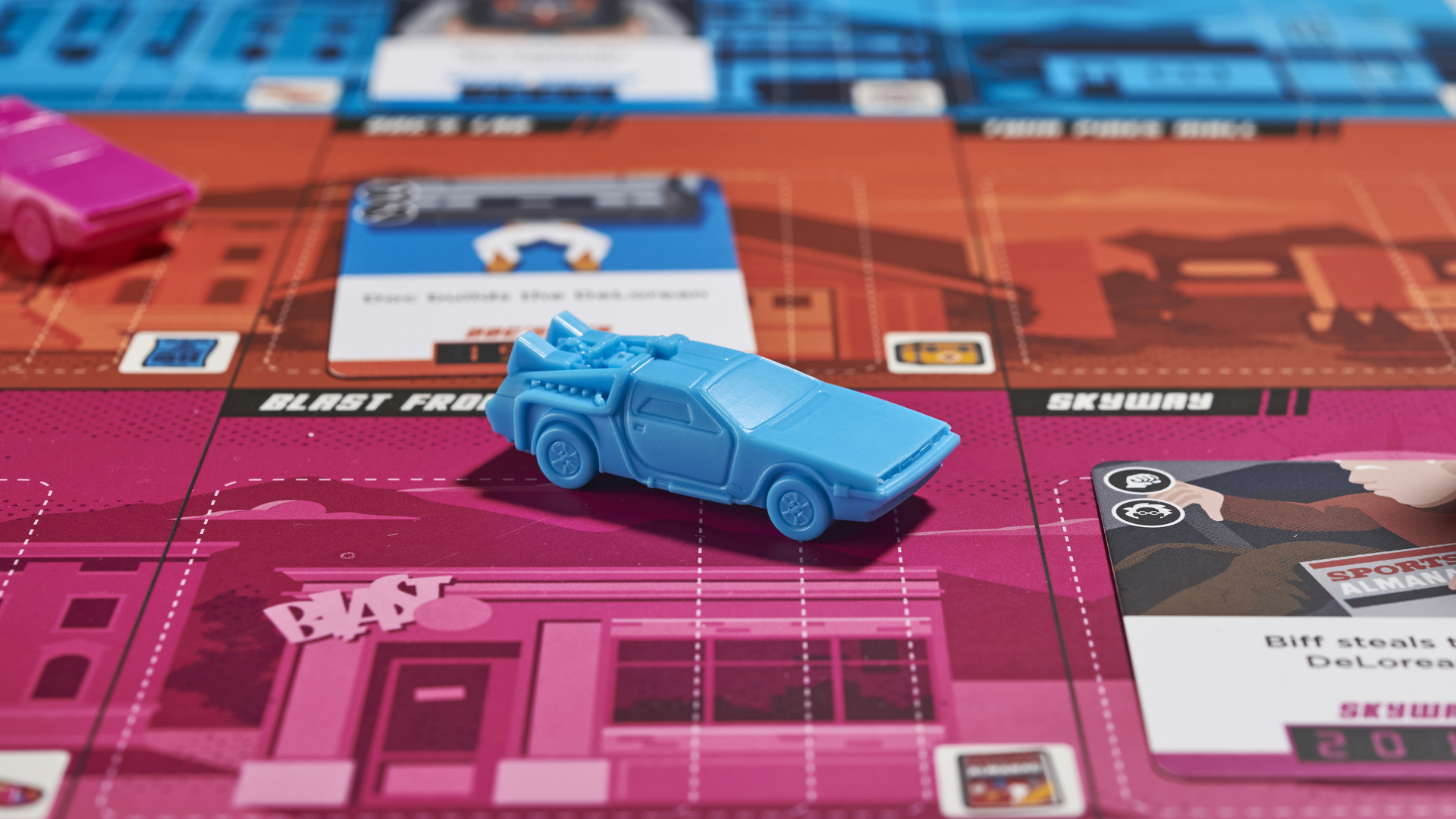
(Image credit: Futurity)
Back to the Future: Dice Through Time: Cost & who it's for
Available for around £25/$thirty, Back to the Hereafter: Dice Through Time is just as family friendly equally the film information technology's based on. It plays upwardly to four players, and it actually works well with any number – including i, if you simply want a game to puzzle out on your own.
Being a cooperative game means that people of different ages can all play together without there existence any kind of handicap, and while the suggested age of 10+ seems well-nigh right to united states, you could go a chip younger when kids are playing with adults, equally long equally they won't mind having suggestions made to them.
Information technology'll have around 40 minutes to an hour to play – more players volition mean more than time.
It's piece of cake to sympathise how the rules work overall, and really playing is quite simple, but there's a petty more complexity than it appears at first – a few fiddly things to remember that will only put it a little out of the attain of younger kids.
However, the difficulty is easy to tweak from 'pretty trivial' to 'maximum brainpower required', so that can as well help kids who sympathize the rules but not the strategy to play information technology without frustration (or for adults who don't want the puzzle to be too intense).
It's also the type of cooperative game that requires you to be highly collaborative for victory, with successful end results at college difficulty levels commonly coming from planning before anyone takes whatever action. There's no hidden information here, then everyone can see what anybody else could do, significant it's easy to strategise together… but that also ways it's possible for one domineering personality to accept over the game, telling everyone else what to do for victory.
Some people don't heed playing with a player like that, especially if information technology works and yous all win! Only it as well drives some people upward the wall, so just know that this is a game where someone could be a real Biff about it.
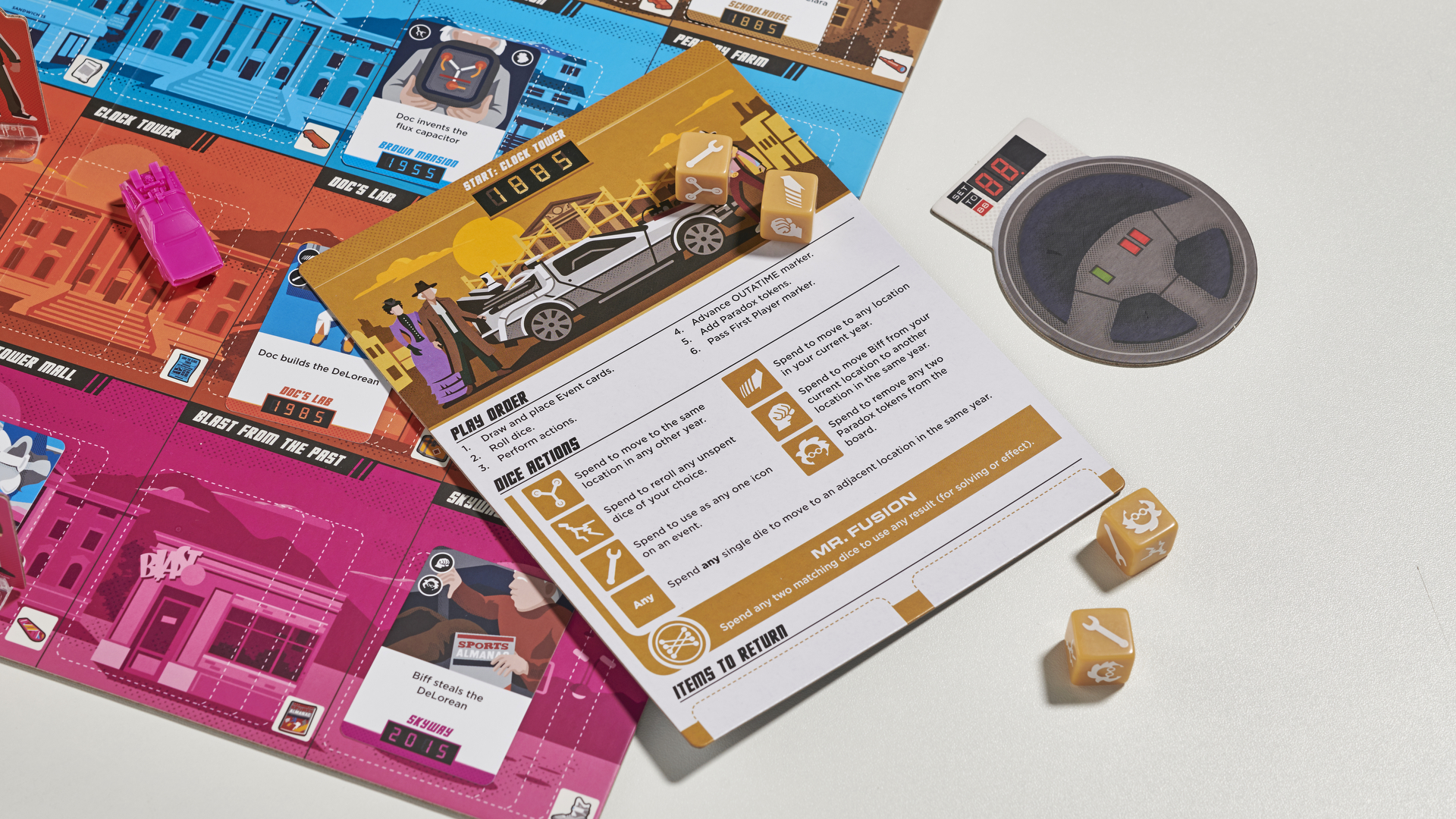
(Prototype credit: Future)
Back to the Future: Dice Through Time: How it plays
The aim of Dice Through Time is to collect objects from the films that have been scattered throughout time and space, and return them to where they came from. Return them all and y'all win! The board represents 5 different locations in four different timelines (arranged in a grid that makes it clear to understand), and these are what players will move between to brand this happen.
The wrinkles are that players can't share the same space without causing more timeline problems, and each timeline has a Biff who moves around the board, and if he'southward on a space, y'all accept to deck him before you tin do annihilation there.
Between rounds, 'Event' cards are drawn from a deck and go placed on the corresponding location on the board – these are moments from the films, and each card has a set of symbols on it that show what'due south needed to complete the Effect, making sure it happens just equally history says information technology should. The whole danger in the game is that the more unsolved Consequence cards there are on the lath, the more the timeline is fracturing, and the more the ominous 'Outatime' tracker goes up the calibration – if information technology reaches the pinnacle earlier you've returned all the objects, you lose.
So what yous'll do on your turns during each circular is move around the board to get to Events, complete them to clear them from the board, and so you get to option up i of the misplaced objects you need to win the game – which you then carry to the location it needs to go to.
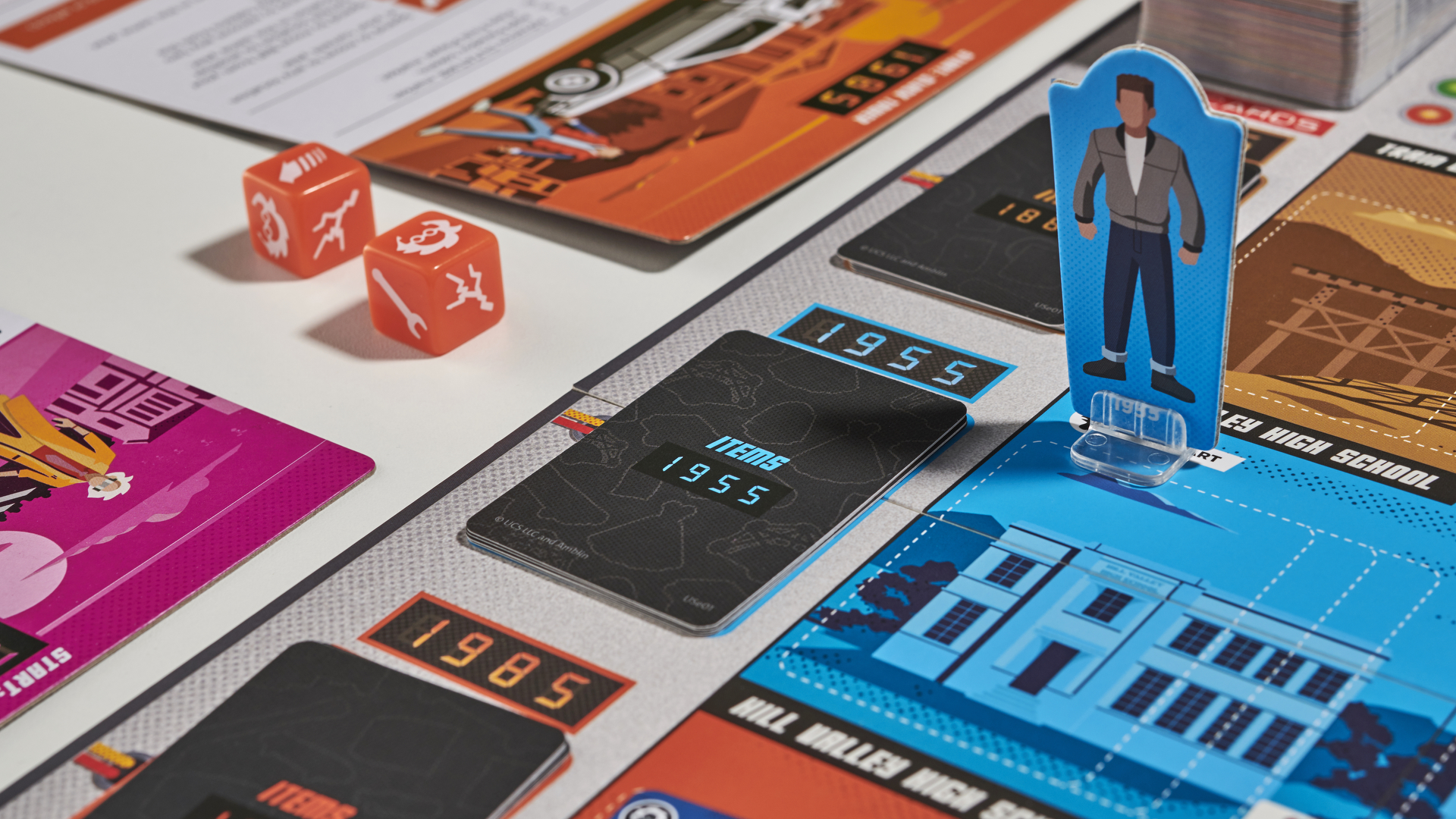
(Image credit: Hereafter)
This is where the dice come in: each player has 4 dice of their own, and at the start of each round, you all gyre them at the same fourth dimension. The symbols that come up up decide what actions you can take that round: ane symbol blazon lets y'all motion locations within the same time; one lets y'all motion through time in the aforementioned location; ane lets y'all reroll other dice; and so on.
These dice are both blessing and curse. When you ringlet and get a cracking combination of symbols for what yous're hoping to practice adjacent, it feels groovy – a little like the thrill of winning at gambling.
But they also mean that sometimes yous want to do something very bones, and the winds of fate mean that yous only… can't. You haven't rolled the right thing.
The game tries to give you iii ways to deal with this element of chance. Start, if you lot have 2 matching symbols, you lot tin treat them like a wild carte, and use them for any activity.
Second, whenever you return one of the objects, you lot get a token that has one of the symbols from the die on, and y'all can use that once to do something extra on a plough, but what symbol you get here is besides up to chance, so may or may not help.
The tertiary way is one of the game'due south fundamental tricks, and actually tin can solve this problem… merely only with enough players. It's possible to leave your dice on the board then that players who are in the future can use them if they're in the same location simply in a later time.
So permit'due south say you lot're in 1885 at the Clock Tower and accept a symbol you don't need – you can go out that die on the Clock Tower, and another players could visit the Clock Tower in 1955, 1985 or 2015 and make apply of information technology. If you left the aforementioned dice in 1985, a player in 2015 tin can use information technology, but not 1 in 1885. And y'all can even leave these dice on the board between turns, so they're ready for side by side time.
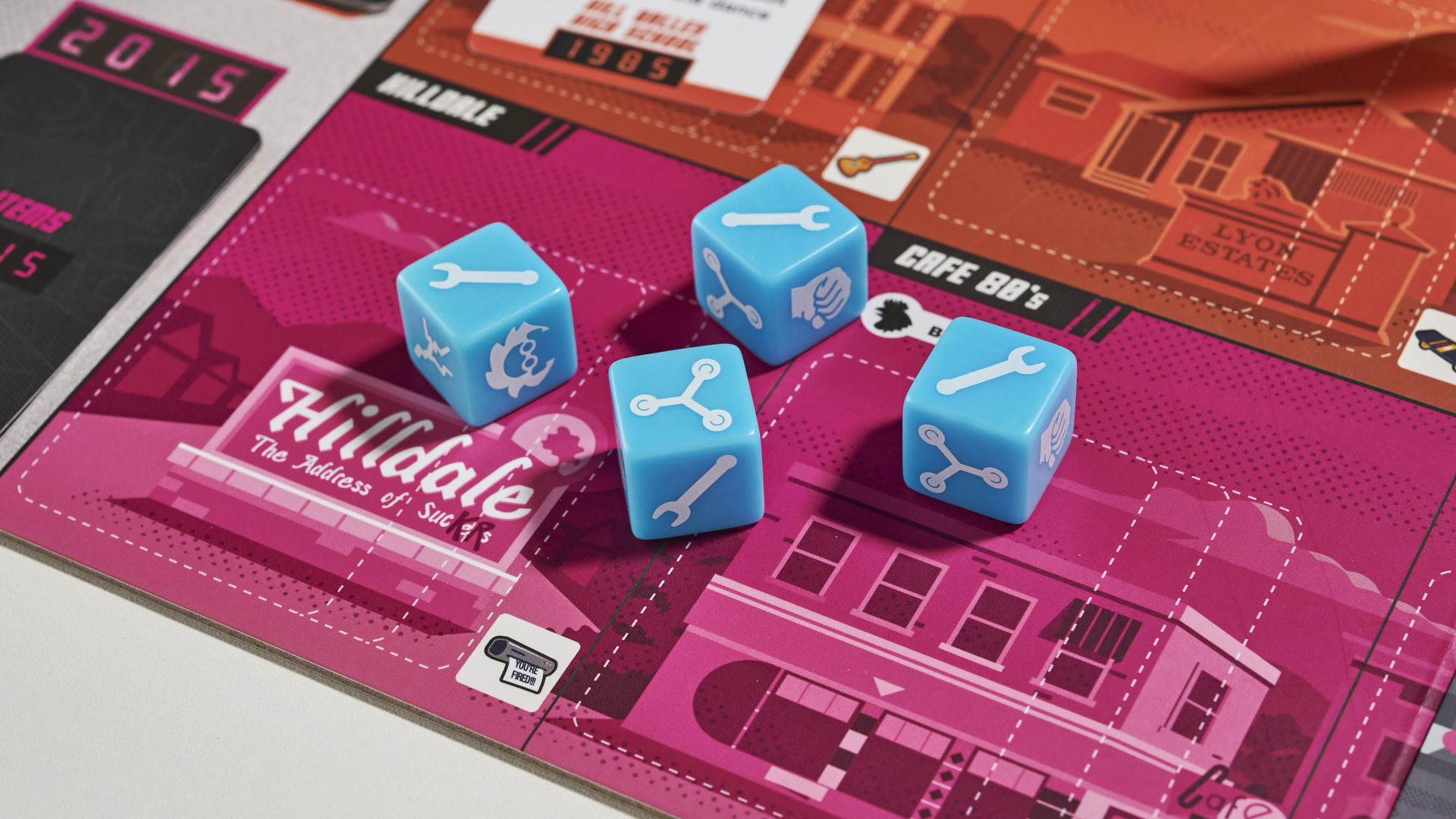
(Prototype credit: Futurity)
When this comes together, it makes the game genuinely magical. It means players are working together across each other'south turns, and makes the theme of the game feel like a real part of playing, not simply a cornball name pasted onto the box, every bit with also many licensed games.
But it's only effective when y'all have a minimum of three players, and is only a key part of the game when you have four – because otherwise you're unlikely to have someone who tin realistically be in the right place at the right fourth dimension.
Usually one of these three tricks will help you out with poor luck on your scroll… and early on in the game, bad rolls don't affair much anyway. But when things get to crunch time, information technology really can exist the case that nothing helps.
It probably sounds like we're criticising Die Through Time a lot on this point, but it's only considering it can exist and then good. The times when the fun stumbles don't happen constantly, just they're all the same frustrating when they do.
That's especially because the game is perfectly designed to ratchet upwards the tension between potentially winning and losing as y'all keep: effectively, every single game we've played has ended in a situation where the final turn would either be a win for us or a loss. Nosotros never had a case where a game felt hopeless or where nosotros just cruised information technology (partly because nosotros made certain nosotros were playing at a challenging level of difficulty).
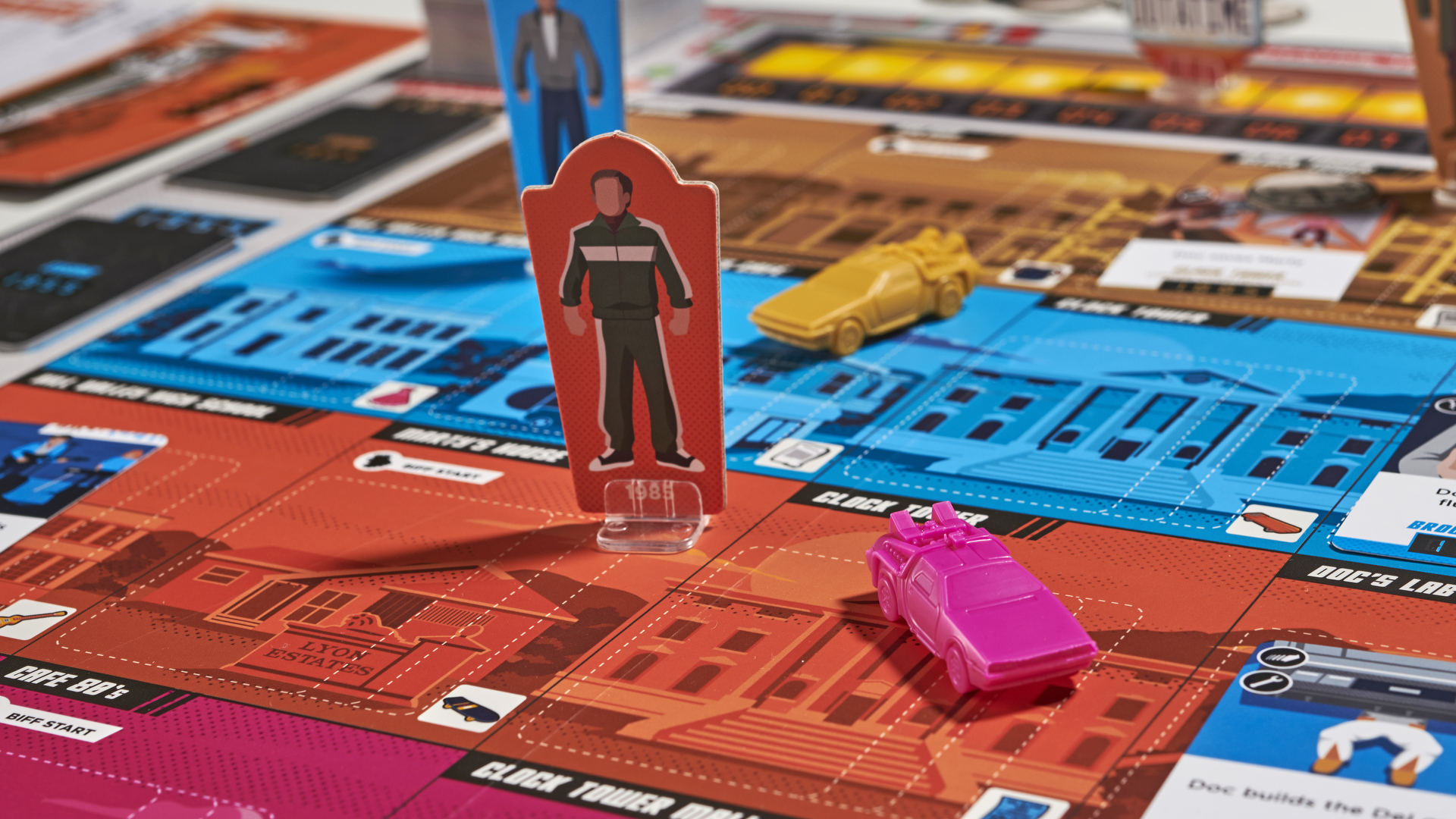
(Epitome credit: Future)
But to give y'all a real-earth example: in one 2-player game, we got to what we knew would be the concluding plow knowing exactly what we needed to practise, which was pretty bones. We merely needed a not-terrible dice scroll to move to a location, deck Biff, clear an Event and return the final piece.
But we didn't roll what we needed, and nosotros'd drawn a special Event bill of fare that stopped us from using the power of combining two matching symbols into a wildcard. We simply couldn't do the quite basic tasks, fifty-fifty though nosotros knew what information technology was.
To be articulate, information technology's fine for a game to crush you on a concluding turn! It happens in games like Pandemic, and we don't mind it at all there. Merely… not like this. Not in a fashion where yous couldn't actually take done anything differently.
Of form, in that case we just cheated – pretending we never drew that Event card, and so were able to win – since it wasn't our fault that the odds betrayed us. Nosotros'd had so much fun playing throughout the game, nosotros really didn't want the last turn to leave this aftertaste of deflation.
That'southward the takeaway of this game, really – it'south massively adept fun, and when it isn't, you lot can always fudge it to fix the problem, if it doesn't feel correct. You just shouldn't take to, ideally.
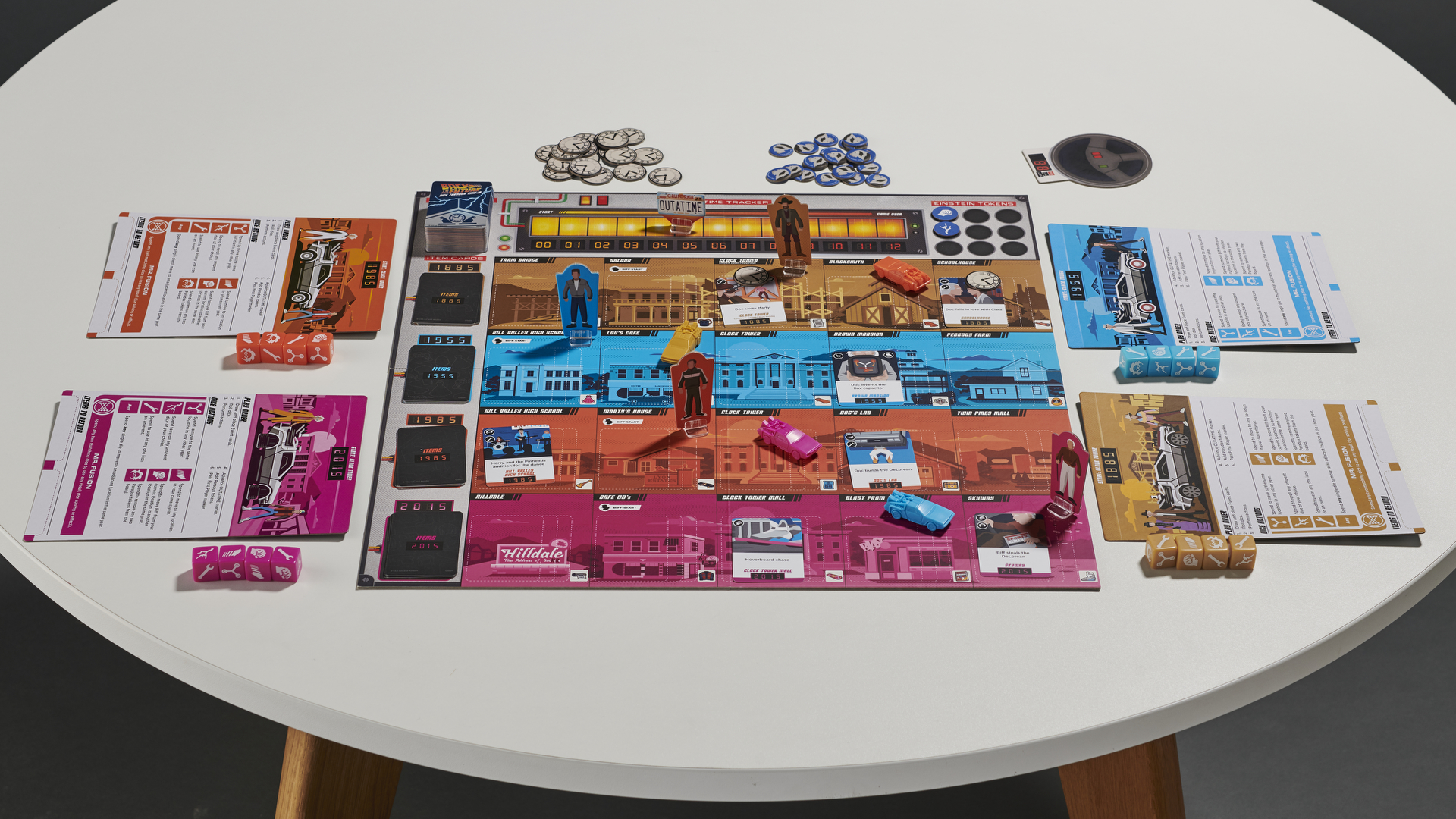
(Image credit: Future)
Back to the Future: Dice Through Fourth dimension: Verdict
In that location's nothing cooler than maxim "Okay, I can travel dorsum to 1955, bulldoze to the schoolhouse, deck Biff, use the tool you lot left me from 1885 to fix the Enchantment Nether The Ocean trip the light fantastic, and render Lorraine's Dress to its rightful place."
Information technology's not merely satisfying in the game, but it feels like you're Marty reciting a plan to Doc – pure movie magic. And so to do all that and know that it's put you ane key stride closer to winning is the perfect bow on information technology.
That's the draw of this game – it's a good cooperative puzzle in a corking big nostalgic hug of a theme that it really it really feels like information technology deserves to wear. It's but that much similar the DeLorean at its center, information technology's got the odd reliability problem.
Back to the Future: Dice Through Time: Too consider
Our selection of the cooperative games is Pandemic, in which everyone works together to terminate the outbreak of diseases around the world while also trying to notice a cure for them. It'due south been around for a decade, but talk nigh a game for our times…
Each player is a specialist with a unique power, and everyone gets just four actions on their turn, and between each player's turn the disease spreads more than. It's a truly expert piece of tension-building blueprint, considering you have to residuum keeping on top of outbreaks while also researching the cures – you tin can't really do both at the same fourth dimension, and you accept a limited number of turns to consummate the game. You lot'll have to showtime making gambles about where in the world is safe, and yous'll exist wrong a lot.
The basic version of Pandemic is a perfect place to beginning, and is actually still very family friendly, but is more fiddly to set than BTTF:DTT, and then if y'all want something that'south quick to bound into, Back the the Future may be the wiser choice.
In that location are also expansions for Pandemic (we very much recommend the 'On The Brink' expansions, which adds lots of diverseness to the game), and if you like the idea but want a faster, cheaper version Pandemic: Hot Zone N America is a slimmed down version fabricated to play in about 25 mins.
Finally, if you like the idea of something involved, there'due south Pandemic: Legacy. This is one of the greatest games e'er made – it starts off as regular Pandemic as described here, but you'll play a campaign with a specific story, where decisions you brand volition really change the lath permanently. Information technology's utterly genius.
If you lot want a cooperative game with a bit more bite, take a look at Jaws – some other picture show game from the aforementioned publisher as BTTF:DTT. In it, most players are working together to track down where the titular shark is; only one actor plays as the shark, trying to eat swimmers without giving abroad their location effectually Amity Island.
Only when the players runway downward the shark, there'southward a twist! Y'all flip the board and the final act plays out on the gunkhole, with the three cooperative players trying to take down the shark, and the shark trying to eat them right up. How well you did earlier in the game determines what options you have in the second phase so information technology all ties together. Like BTTF:DTT, it actually uses its theme well, and is a dandy cost.
Source: https://www.t3.com/us/reviews/back-to-the-future-dice-through-time-board-game-review
0 Response to "Review of Superpacs Board Game by Dice Tower"
Post a Comment